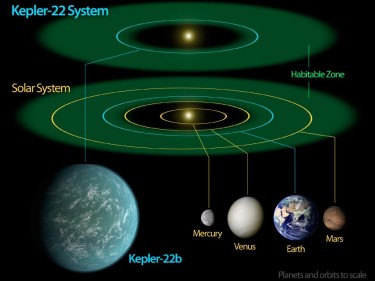مع ما لا يقل عن مائة بليون مجرة يمكن ملاحظتها ومائتي بليون نجمة في درب التبانة لوحدها، فإن احتمالية وجود كواكب ملائمة لظروف حياة الإنسان قليلة. ولكن ليس هناك أدلة قوية لوجود مثل هذه الكواكب.
بالرغم من ذلك، ففي 5 ديسمبر / كانون الأول 2011، أعلنت وكالة الفضاء الأمريكية ناسا عن إكتشاف كيبلر- 22ب عبر مسبار الفضاء كيبلر، وهو كوكب على مسافة مناسبة من نجمه لأن يكون له درجة حرارة تحتمل السكن. وكان هذا رد فعل المدونين العلميين إلى الخبر مع تحليلات ونظريات خاصة بهم.

رسم تخطيطي يقارن بين نظام الطاقة الشمسية للأرض ونظام كيبلر 22 ب، النظام الذي يحتوي على أول كوكب صالح للحياة في تاريخ رحلة مسبار كيبلر الاستكشافية – الصورة تصوير ناسا
سلمان حميد أستاذ علم الفلك في كلية هامبشير متحمس على الإكتشاف:
Yes. Astronomers have the first confirmed detection of an earth-like planet located in the star's habitable zone – the distance from the star where water can exist in liquid form…The discovery is amazing, if not really surprising. There are just too many planets out there, and we are bound to find planets in places that match conditions of the Earth. And life is also likely to be quite common. Life that can build telescopes? Don't know.
ويعطي مزيداً من التفاصيل:
So what do we know about this planet? It is called Kepler 22b. This is the sexiest name that astronomers could come up with (actually, it is because it is discovered by Kepler telescope). It is located about 600 light years away – just far enough that we can't start thinking about packing our bags for a trip…
Is there life there? We don't know. This planet was detected when it passed in front of its star, dimming the light of the parent star a bit. We do not have an image of the planet. When we do – and it may take years – then we can potentially analyze the composition of its atmosphere. The presence of oxygen in the atmosphere will be a good indicator for life, as oxygen in our own atmosphere is a by-product of life itself.
We are getting closer to finding life.
هل هناك حياة هناك ؟ لا نعلم. تم إكتشاف هذا الكوكب عند مروره أمام النجم التابع له، معتماً ضوء النجم الأم قليلاً. ليس لدينا صورة للكوكب. عندما نفعل ذلك -وقد يستغرق ذلك سنوات- عندها يمكننا تحليل غلافه الجوي. وجود الأكسجين في الغلاف الجوي سيكون مؤشراً جيداً للحياة، كوجود الأوكسجين في غلافنا الجوي منتج ثانوي من الحياة نفسها.
نحن نقترب من إيجاد الحياة.
هيلين تشابيل، فلكية سابقة درست الفيزياء في جامعة كولورادو، قدمت ثلاثة أسباب لعدم إكتراثها بكيبلير 22 ب:
Kepler is finding hundreds of extrasolar planets, and it’s going to keep on finding hundreds more until the project’s funding runs out. Kepler 22b is just the poster child for NASA’s announcement of more than 1,000 new planet candidates.
[..]
Venus [like Kepler 22b] isn’t too far outside the habitable zone…[but] we know that it’s actually hot enough to melt lead on the surface. Venus is not a nice place for life, but extraterrestrial astronomers would have no way to figure that out if they used the same technology as us. Perhaps folks on Kepler 22b are giddy at the prospect of life on Venus.
[…]
We have no clear way to figure out whether Kepler 22b — or any other extrasolar planet — actually harbors life.
[..]
كوكب الزهرة [مثل كيبلر 22ب] ليس بعيدة جداً خارج منطقة السكن… [لكن] ونحن نعلم أنه في الواقع حار بما فيه الكفاية لإذابة الرصاص على سطحه. الزهرة ليس مكاناً لطيفاً للحياة، ولكن علماء الفلك خارج الأرض لن يكون لهم أي وسيلة إلى إكتشاف ذلك إذا استخدموا نفس التكنولوجيا مثلنا. ربما الناس على كيبلر 22 ب نسوا إحتمالية الحياة على كوكب الزهرة.
[…]
ليس لدينا أي وسيلة واضحة لمعرفة ما إذا كان كيبلر 22ب — أو أي كوكب آخر خارج المجموعة الشمسية — مناسب للحياة.
لكنها وجدت أجد الجوانب الإيجابية من الحماس على الاكتشاف:
Discoveries like Kepler 22b get everyone excited about astronomy, and open up opportunities to teach folks (especially kids) about science.
[…]
So hooray for science, even if I just burst your Kepler 22b bubble.
[…]
لذا مرحى للعلم، حتى لو اني فجرت فقاعة كيبلر 22ب.
ناقد آخر، وهو مدون مجهول يدرس الأعاصير، يناقش المفاهيم الخاطئة حول كيبلر 22 ب ملخصاً ذلك:
It's a first step, and it's a step we've never taken before. That's big news! And the fact that we still have 48 other candidate planets in the habitable zones of their respective stars is a Big Deal. But it's news in a way that a lot of the media seems to be missing out on.
في قسم التعليق، المدون يناقش المسافة الفعلية بيننا وبين كيبلر 22ب.
At present top speeds, it'd take us, what, tens of millions of years to get there. That's a bit beyond even the scifi-ish dreams of generation ships and cryostasis. And the corollary to that: any further observations we make will be of the planet as it was 600 years ago.
600 سنة ضوئية قد تبدو كثيرة، ولكنها تعتبر مثل دقيقة من الزمن بالنسبة للفلكيين، حتى لو إستغرق الأمر ملايين السنين للسفر إلى كيبلر 22ب بسرعتنا الحالية. إذا تمكنا من بناء آلة قريبة من سرعة الضوء، قد يكون من الممكن أن نسافر إلى كيبلر 22 ب ونبقى على قيد الحياة، وفقاً لنظرية آينشتاين النسبية، فان المسافرين سيستطيعون السفر لنحو 24 سنة.
بعض المدونين توسعوا في فكرة السفر إلى الفضاء.
كريس روديل كاتب حر في مدونة 8 أيام إلى أميش، كتب ما يلي:
I’m sure the Republicans thought, “Hallelujah! Now, there’s a place the lousy Democrats can Occupy for as long as they want!”
The Democrats thought, “You can bet greedy Republicans are already packing their Louis Vuitton suitcases, drilling rigs and barrels of Halliburton fracking liquids to exploit yet another pristine wilderness before Obama declares it off-limits.”
أما الديموقراطيون “أراهن أن الجمهوريين الجشعون قد حزموا حقائب لويس فيتون، ومعدات الحفر وبراميل هاليبرتون لإستغلال البرية قبل أن يعلنها أوباما خارج الحدود”
مدونة الملحد، لتريستان د فيك، مدرس لغة إنجليزية في اليابان، متفائل حول التواصل مع كيبلر 22ب، لو كانت لديها حضارة للتواصل الفضائي . وهو يقترح بناء ثقب (إختصار فرضي عبر الزمان) الأمر الذي سيجعل من الممكن الإتصال. إنه يعترف مع ذلك أن إقتراحه غير ممكن إلا نظرياً.
يخلص فيك فيما يبدو أنه ملخص جيد لـكيبلر 22ب:
Regardless of whether or not we could ever make first contact with an alien race, it seems to me that Kepler 22B represents a dream which all people share–the dream of adventure, of interstellar travel, and of being a part of history. It seems to me, we may already be witnessing history in the making and not even truly be aware of it.






